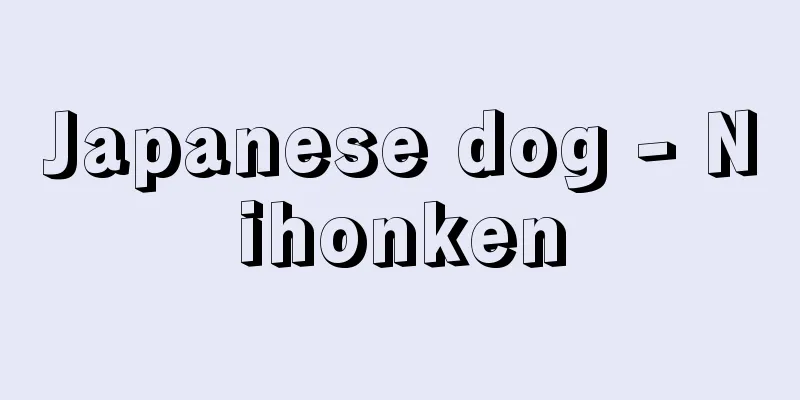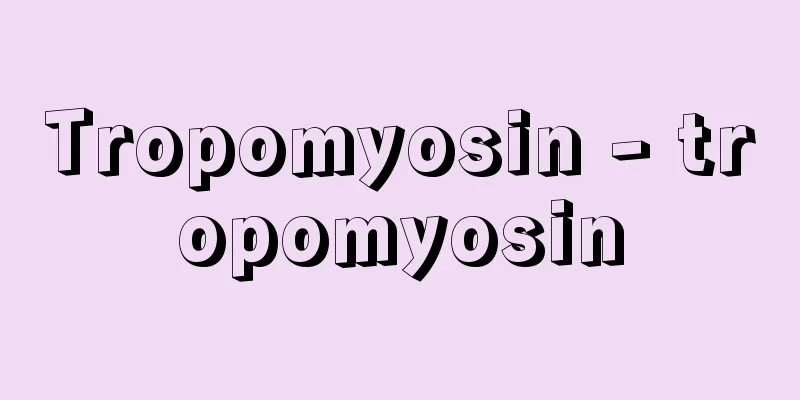Japanese dog - Nihonken

|
A general term for breeds of domestic dogs that belong to the family Canidae, order Carnivora, class Mammalia, and have upright ears and curled or pointed tails that are native to Japan. There are six Japanese dog breeds recognized by dog breed organizations (such as the Japan Kennel Club and JKC): Akita, Hokkaido, Kishu, Shikoku, Kai, and Shiba. Other breeds that are not native to Japan but originate from Japan include the Chin, Japanese Terrier, Tosa Fighting Dog, and Japanese Spitz, but these are not called Japanese dogs. [Mitsuko Masui] History and usesThe Japanese wolf, a wild canid species, also lived in Japan, but it is not thought to be the ancestor of Japanese dogs. It is believed that the ancestors of Japanese dogs came to Japan with human migration. The oldest fossils of Japanese domestic dogs were excavated from shell mounds in Kanagawa Prefecture and elsewhere, and are said to be around 9,500 years old. Japanese dogs have been used primarily as hunting dogs, with medium-sized ones for hunting bears, deer, and wild boar, and small ones for hunting small animals and birds, but unlike Western dog breeds, they have not been bred to have significant artificial influences on their body shape, and have instead been bred in their natural state. [Mitsuko Masui] keepAlthough Japanese dogs have a long history, no special movement to preserve them arose until the Taisho era. Western dog breeds were introduced to Japan as early as 1583 (Tensho 11), and as exchanges with foreign countries intensified, their numbers gradually increased, and exchanges with native breeds also progressed. In particular, during the Meiji era, mishmash progressed rapidly due to the popularity of dog fighting. As people's attention was drawn to rare Western dogs rather than the familiar native breeds, pure Japanese dogs gradually disappeared. However, as their numbers dwindled, a preservation movement finally arose, and in 1928 (Showa 3) the Japanese Dog Preservation Society was founded, and full-scale efforts were made to create pedigree registers and to preserve and improve breeds. In the past, there were many different breeds of Japanese dogs named after the local area all over the country. The Ministry of Education (now the Ministry of Education, Culture, Sports, Science and Technology) designated highly pure native breeds as natural monuments and tried to preserve them as cultural assets. Japanese dog breeds designated as natural monuments include the Akita dog (designated in July 1931), Kai dog (January 1934), Kishu dog (May 1934), Koshi dog (December 1934, considered extinct), Shiba dog (December 1936), Shikoku dog (June 1937), and Hokkaido dog (December 1937). [Mitsuko Masui] current situationJapanese dogs are fixed as breeds and have a strong fan base. After World War II, Akita dogs went to the western United States and gained more fans. Small Shiba dogs have also been introduced overseas, and the number of Japanese dogs kept and exported has increased significantly. In addition to the six dog breeds mentioned above, there used to be matagi dogs, but now only a very small number are kept by enthusiasts, and Iwate matagi dogs, which were seen in small numbers after the war, are thought to have been absorbed into the medium-sized dog category. The decline of matagi dogs is thought to be due to the decrease in professional hunters as well as dog shows. Dog breed organizations once divided Japanese dogs into large, medium, and small, and did not place importance on regional characteristics, so in order to win top prizes in dog shows, there were crossbreeds between medium-sized dogs, such as Hokkaido dogs and Shikoku dogs, or Kishu dogs and Shikoku dogs. Matagi dogs, which are too large to be classified as medium-sized but not large, were at a disadvantage in shows, and so they were naturally absorbed into the medium-sized dog category. There are small Shiba-inu dogs such as Shinshu Shiba and San'in Kogata, but most of the current Shiba-inu are of the Shinshu Shiba lineage. However, San'in Kogata are still bred in some areas. Also, outbreeding has disappeared, and each regional dog breed is recognized as a breed. There may be a way for San'in Kogata to revive. In the Gifu and Aichi regions, there was a small dog called Mino Shiba before World War II. This Mino Shiba has not been officially recognized as a breed because of doubts about its purity due to the short body, the unique scarlet color, and the black spots on the tongue. However, in terms of genetic composition, it is undoubtedly a lineage of Japanese dogs, and it can be said to be a valuable native breed along with the San'in Kogata, which is overshadowed by the Shinshu Shiba. Other small dog breeds that are no longer seen include the Satsuma dog and the Shikoku Kogata. [Mitsuko Masui] Migration routeAs mentioned above, it is believed that Japanese dogs were not domesticated from the Japanese wolf (now extinct) based on old bones. The reason is that the bones of old Japanese dogs were small, while the bones of the Japanese wolf were large. The types of various proteins contained in dog blood were biochemically studied, and the ratio of genes that control these types between dog breeds was analyzed using a computer. As a result, the genetic composition that controls blood protein types was significantly different between Japanese and Western dog breeds. Among Japanese dog breeds, the Hokkaido dog was close to the native dog breeds of the high mountain region of Taiwan. In addition, the genetic composition of Japanese dog breeds other than the Hokkaido dog was found to have many similarities to the Jindo dog, a native dog breed of Korea. From this, it was thought that old dogs first came to Japan from the south, and then new dogs were introduced from the Korean peninsula, and the ancestors of most of the current Japanese dog breeds were created by interbreeding of these two. It was estimated that this interbreeding hardly occurred in the case of the Hokkaido dog. The origin of such Japanese dogs is noteworthy in its connection with human history, where the Jomon people were the indigenous people of Japan, and then the Yayoi people came to Japan via the Korean peninsula. It is thought that the Ainu of Hokkaido had an old type of dog, which became the current Hokkaido dog. [Yuichi Tanabe] "Exploring the Mysteries of Ancient Japanese People through Dogs" by Yuichi Tanabe (1985, PHP Institute) [References] | | | | | | | |Source: Shogakukan Encyclopedia Nipponica About Encyclopedia Nipponica Information | Legend |
|
哺乳(ほにゅう)綱食肉目イヌ科に属する家畜イヌのうち、日本土着の立ち耳、巻き尾または差し尾をもつ品種の総称。犬種団体(日本犬保存会、JKCなど)が認める日本犬は、秋田犬、北海道犬、紀州犬、四国犬、甲斐(かい)犬、柴犬(しばいぬ)の6犬種である。ほかに、土着ではないが日本を原産国とする品種としては、チン、日本テリア、土佐闘犬、日本スピッツなどがあるが、これらは日本犬とはよばない。 [増井光子] 歴史と用途日本にもイヌ科の野生種としてニホンオオカミが生息したが、これは日本犬の先祖とは考えられていない。日本犬の先祖は、人の移住につれて日本へ渡来したとみなされている。日本最古の家イヌの化石は、神奈川県などの貝塚で発掘され、9500年ほど前のものといわれている。日本犬は主として獣猟犬として、中形のものはクマ、シカ、野生イノシシ猟に、小形のものは小獣、鳥猟などに用いられてきたが、西洋犬種のように体形に著しい人為的影響を及ぼすような作出はなされず、むしろ自然のままに飼育されてきた。 [増井光子] 保存長い歴史を有する日本犬であるが、大正時代に入るまでは特別に保存しようという運動もおこらなかった。西洋犬種の渡来は1583年(天正11)にすでにみられ、外国との交流がしげくなるにつれてしだいにその数を増し、在来種との交流も進んだ。とくに明治時代になると、闘犬の流行もあって雑化は急速に進んだ。身近に見慣れた在来種より、珍しい西洋犬に人々の目がひかれた結果、徐々に純度の高い日本犬は姿を消していった。しかし、数が少なくなってようやく保存運動がおこり、1928年(昭和3)日本犬保存会が設立され、血統台帳の作成や、品種の保存と改良が本格的に行われるようになった。 かつて日本犬には、全国各地にその土地の名をつけられた多くの系統がみられた。文部省(現文部科学省)は純度の高い在来種を文化財として天然記念物に指定し保存を図った。日本犬種のうち天然記念物の指定を受けた品種には秋田犬(1931年7月指定)、甲斐犬(34年1月)、紀州犬(34年5月)、越(こし)の犬(34年12月。絶滅とみなされる)、柴犬(36年12月)、四国犬(37年6月)、北海道犬(37年12月)がある。 [増井光子] 現状日本犬は品種として固定され、根強いファンを有している。第二次世界大戦後、秋田犬はアメリカ合衆国西部に渡り愛好者を増やした。小形の柴犬の海外進出もみられ、日本犬のなかで飼育数、輸出数ともその伸びが著しい。前述の6犬種のほか、かつてはマタギ犬なども存在したが、現在はごく少数が愛好者に飼育されているにすぎず、戦後多少みられた岩手マタギは中形犬のなかに吸収されたとみられる。このマタギ犬の衰退には、専門猟師の減少のほかにドッグショーが関与していると思われる。犬種団体はかつては日本犬を大形、中形、小形と分け、地域色を重視しなかったため、ドッグショーの上位入賞を目ざして、中形どうしなら北海道犬と四国犬とか、紀州犬と四国犬といった異系交配がなされたことがある。中形に入るにはサイズが大きすぎ、大形には不足のマタギ犬はショーでは不利で、自然に中形犬のなかに吸収されたようである。 小形犬である柴犬にも、信州柴のほか山陰小形などがあったが、現在の柴犬はほとんど信州柴の系統である。しかし、地域的には山陰小形もまだ飼育されている。また、異系交配は影を潜め、各地方色豊かな犬種がそれぞれ一犬種として認められている。山陰小形にも復活の道は残されていよう。岐阜・愛知地方には、第二次世界大戦前から美濃(みの)柴といわれる小形犬がいた。この美濃柴は、短胴のものがみられること、毛色が独特の緋赤(ひあか)のものが多いこと、舌に黒斑(こくはん)をもつものが出ることなどから、その純度を疑われ公認犬種にはなっていない。しかし、遺伝子構成上は紛れもない日本犬の一系統とされるものであり、信州柴に押される山陰小形ともども貴重な在来種といえよう。そのほかの小形犬種としては、薩摩(さつま)犬、四国小形もみられなくなっている。 [増井光子] 渡来経路前述のように日本犬は、古い骨からみてニホンオオカミ(すでに絶滅した)から家畜化されたのではないと考えられている。その理由は、古い日本犬の骨は小形であったのに対し、ニホンオオカミの骨は、大形であったことである。 イヌの血液に含まれている種々のタンパク質の型について生化遺伝学的に調べられ、その型を支配している遺伝子の構成比率の犬種間の違いについてコンピュータを使って分析が行われた。その結果、血液タンパク質型を支配している遺伝子構成が、日本犬種と西洋犬種とは著しく異なっていた。日本犬種のなかでは、北海道犬は台湾の高山地方の在来犬種と近かった。また北海道犬を除く日本犬種の遺伝子構成は、韓国の在来犬種である珍島犬と多くの類似性がみいだされた。このことから、日本国土には初め南方から入った古いイヌがいて、その後朝鮮半島から新たにイヌが入り、この両者の混血により現在の大部分の日本犬種の祖先がつくられたと考えられた。北海道犬では、この混血がほとんど行われなかったと推定された。このような日本犬の起源は、日本に先住民族として縄文人がおり、その後朝鮮半島を経て弥生(やよい)人が渡来したという、人の歴史との関連が注目される。北海道のアイヌが古い型のイヌをもっており、これが現在の北海道犬になったと考えられる。 [田名部雄一] 『田名部雄一著『犬から探る古代日本人の謎』(1985・PHP研究所)』 [参照項目] | | | | | | | |出典 小学館 日本大百科全書(ニッポニカ)日本大百科全書(ニッポニカ)について 情報 | 凡例 |
Recommend
Tsugunobu Sato - Tsugunobu Sato
A military commander in the early Kamakura period...
Haiying County
…At the same time, Hailing County was established...
Large ginkgo flower - Large ginkgo flower
...Distributed in Hokkaido and Honshu. Nipponicus...
Green meat - Aoniku (English spelling)
A pale blue-green discoloration of tuna meat that ...
Wanyan-ei
…reigned from 1189 to 1208. His given name was Wa...
Ottotail le Roman - Ottotail le Roman
…Their work consisted of creating, developing pla...
Kaiten
〘Noun〙① (Meaning to turn the heavens around) To co...
Seal preservation - Inzon
...A book in the form of a book made by stamping ...
Kazusumi Enami - Enami Wacho
?-? A Japanese mathematician in the early Edo per...
Extinct volcano
...Therefore, volcanoes from ancient geological t...
Adachi (name) - Andachi
…He was the son of Kamatari's cousin Kome and...
Jiandao Agreement
...Mild grains and paddy rice were cultivated, an...
Namegawa [town] - Namegawa
A town in Hiki County in central Saitama Prefectur...
Badger baiting
...In folklore, the raccoon dog is the equivalent...
English Review
…He collaborated with J. Conrad on works such as ...


![East [village] - Azuma](/upload/images/67cad45433cfc.webp)






